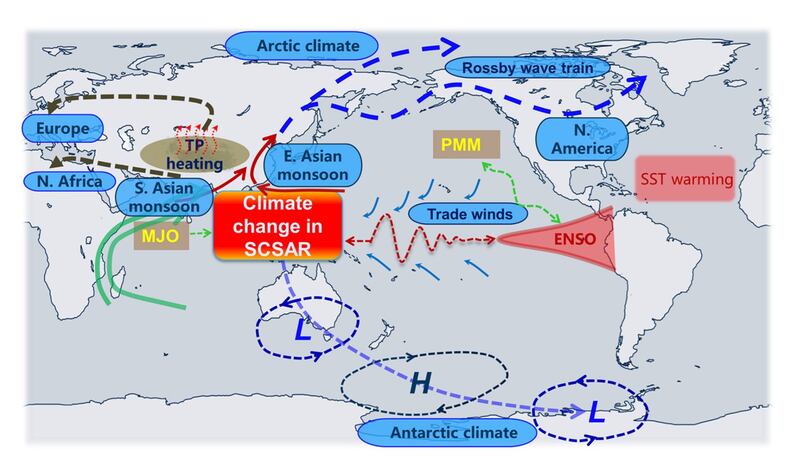The impact of climate change in the South China Sea and its surrounding areas on the local and global weather system could be “profound,” new scientific research has found.
The "unique characteristics" of climate change in the South China Sea and surrounding area (SCSSA) – such as the Indo-Pacific region, Southeast Asia, and the Tibetan Plateau – include rapid warming in key regions, leading to increased precipitation during the Asian summer monsoon and notable shifts in the frequency and origin of tropical cyclones, the researchers said in a study published in the Ocean-Land-Atmosphere Research journal on Tuesday.
The alterations in weather patterns within this region have a ripple effect on a global scale, influencing atmospheric circulation, oceanic currents, and the overall climate system, the researchers said.
The South China Sea, located in the eastern part of Southeast Asia, is a partially enclosed sea surrounded by various nations such as China, Vietnam, the Philippines, and Malaysia. Renowned for its diverse biological richness, it plays a crucial role in the worldwide climate system.
“Climate change in the South China Sea and its surrounding areas is very complex. It has a significant impact on shaping not only regional climates but also exerting far-reaching impacts on weather and climate patterns across the globe,” said Song Yang, a professor at Sun Yat-sen University in Zhuhai, China.
The South China Sea is experiencing a significant rise in sea surface temperatures due to global warming, leading to more powerful typhoons and hurricanes with increased frequency and severity, resulting in catastrophic consequences, substantial loss of life and property damage in coastal areas.
Climate change has also disrupted rainfall patterns in the area, leading to extreme weather events like droughts or heavy rains, which significantly impact agriculture, water resources, and ecosystems.
This week’s study highlighted the Hadley circulation’s expansion, a key atmospheric pattern between the equator and subtropics, and a broader influence on the Madden-Julian Oscillation, an essential tropical atmospheric disturbance.
The researchers said that increased atmospheric convection over the SCSSA can result in abnormal descending air movements, leading to drought conditions and increased humidity in southern China, South Asia, and northern Africa during the boreal – or northern region – spring and summer.
The paper forecasts increased precipitation across South Asia, East Asia, and northern Australia, attributed to warmer sea surface temperatures, a heightened water vapor supply, and intensified circulations over the South China Sea.
The research also indicates that under various projected future scenarios, the impacts of climate change in the SCSSA on both local and distant weather and climate extremes are likely to intensify.

Last week, the United Nations’ World Meteorological Organization (WMO) said the global temperature reached a record high in 2023, fast approaching the critical 1.5 degrees Celsius threshold above pre-industrial levels, a key upward limit in the 2015 Paris climate agreement to save the earth from devastating impacts.
Utilizing six leading international datasets, the WMO reported Friday a new annual average temperature of 1.45 C compared to the pre-industrial era (1850-1900), with every month from June to December setting new records.
Notably, July and August were the hottest months ever recorded. Regional temperature breakdown was not provided.
Midway through last year, the Pacific Ocean region transitioned from the cooling effects of La Niña to the warming influence of El Niño. Since El Niño typically significantly impacts global temperatures after it peaks, 2024 is expected to be even warmer, according to scientists.
“While El Niño events are naturally occurring and come and go from one year to the next, longer-term climate change is escalating, and this is unequivocal because of human activities,” said WMO Secretary-General Celeste Saulo.
Long-term monitoring of global temperatures, alongside other indicators like atmospheric greenhouse gas levels, ocean heat and acidification, sea level, sea ice extent, and glacier mass balance, provide insights into the changing climate, blamed primarily on fossil fuel usage.
Edited by Mike Firn and Taejun Kang.
